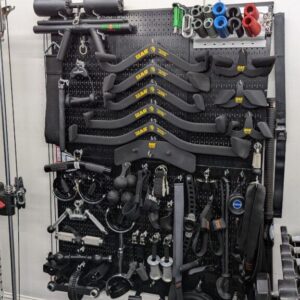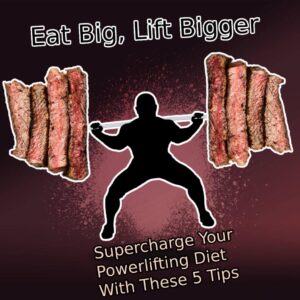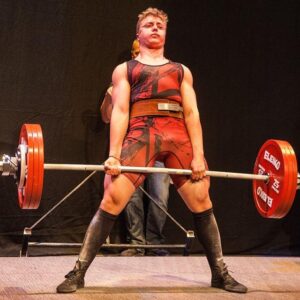4 Best Ways To Improve Your Recovery For Powerlifters
The one universal truth about being a powerlifter, is that whatever PR you smash today, is old news tomorrow. Lifts you never could have dreamed about, don’t even register on your radar shortly after completing them. You are always on the hunt for the next PR, the next big lift, the next goal.
To do that, we have to push our bodies beyond what we once thought was possible. More sets, more reps, more weight, more work… In that pursuit we search out ways to improve our abilities to recover. And this is how we end up chasing down every recovery tool on the planet. But should you? Do any of them work? I used my first foam roller way back when Eric Cressey talked about them on T-Nation over 15 years ago. Since then I’ve used a handful of different foam rollers, owned half a dozen massage guns, multiple compression devices, two different Electric Muscle Stim units, and more.
Today we’ll dig into How to Improve Recovery for Powerlifters by digging through what works, and what doesn’t.
The majority of this article is available in Video Format here.

Table of Contents
Key Notes
The 4 Best Ways To Improve Your Recovery For Powerlifters are through Training Within Your MRV, Improving Passing Recovery, Nailing Your Nutrition, and sprinkling in some Active Recovery Tools.
Transparency Note
Some of the items and links in this article might be affiliate links, or might be linked to a Sponsor of the Garage Gym Competition. These links and sponsorships help fund the website, the competition itself, the newsletter, non-profit donations, and everything else we do FOR FREE here at the GGC. I like to be transparent so you know what is up. I appreciate the support if you choose to use the links.
Foundations of Recovery For Powerlifters
Renaissance Periodization has a great chart about recovery that we are going to steal today and lean on heavy for our discussion. We will cover the first 4 items for recovery, as they have the largest potential for impact to our success.

Training Within Your MRV
The foundation of recovery, is to not exceed your capacities. Basically, if you do more hard work than your body can handle, you can’t recover. Kelly Starret once put it, that you haven’t worked hard enough, long enough, to work that hard.
So, your training needs to land somewhere between what they call Minimum Effective Volume, which means the least amount you can do to make gains, and Maximum Recoverable Volume, which is the most you can do and still recover. This topic came up during my Chat With Chad when setting up JuggernautAI for the first time.
There are a bunch of factors that feed into this, including your age, gender, strength levels, your daily activity levels outside of the gym, stress levels, just your own genetics, and more. But the basic idea is that you don’t want to dig too deep of a hole for yourself to get out of, because you cant!
Passive Recovery
The next item on our list is rest. Rest can come in a number of ways. Taking a break on the couch to watch some TV with the family, practicing meditation, disconnecting, turning your brain off, having fun, or otherwise forgetting that you have bills and obligations. Or the big one, sleeping.

Considering how we are supposed to spend 1/3 of our lives sleeping, this is probably a no-brainer that rest plays a vital role in getting us back together in one piece. Sleep is tied to mental and physical health, mental and physical performance, and everything from digestion to reducing risk of alzheimers and more.
Nutrition
If you aren’t eating right, getting your protein, drinking your water, eating your fruits and vegetables, and getting adequate calories to feed your workouts… well, Jay Cutler, 4x Mr Olympia, once said that you don’t even belong in the gym if you aren’t paying attention to your diet.
Not putting effort here is a limiting factor in your recovery, your gains, and your health. If you are reading this and not taking this seriously, stop it. Be an adult, eat something green, so you can live longer, live better, and lift bigger.
Active Recovery
The last piece we are going to look at today, is the Active Recovery slice of the pyramid. This is where you do something to expedite the recovery process. Ice baths, saunas, massage guns, chiropractor appointments, massage, compression, and more.
Where rest is you chilling and letting recovery take care of itself, this is you taking an active role in the process. However, the MAJORITY of recovery tools have caveat. The old ideas that foam rollers were breaking down scar tissue and adhesions is bunk. Adding more and more painful experiences to your daily routine by loading up heavy metal objects onto your legs and arms, wrapping, strapping, and beating yourself into a fruit leather, is not a way to recover.
In fact, a lot of these could actually have the opposite effect. They can add more recovery requirements to our muscles and tissues, can slow down our healing process, and even lessen our growth.
Ice Baths Don’t Work
If you are a competitive athlete who is competing in back-to-back events like the Olympic games, or even baseball players with 172 games a year, your lifestyle in-season looks a bit different than the rest of us. You need to stay in one piece, for as long as you can, and perform at your best in the next event or game, over and over and over. You aren’t necessarily looking to build muscle, strength, and speed during your competitive season. You simply need to reset the clock every day for the next event.
Some of the tools on the market make perfect sense for you, in this very particular situation. Ice Baths are a good example, they can be used between high output competitive events to help you compete at your highest level again and again and again. They blunt the inflammation process, which lets your body essentially skip a lot of the soreness and acute pain associated with a good workout, so you can get right back to doing your thing the next day.

But for your average lifter, they come with a lot of caveats that make them, in my research and opinion, a poor addition to most people’s repertoires. Blunting that inflammation process is essentially turning off the signals your body needs to grow bigger and stronger. So, you have to keep them far and away from your workouts to not minimize your hard work. Pretty hard to make progress as a powerlifter if you never get any gains from your workouts.
Ice Baths are NOT an enjoyable experience. This likely means that they are a cortisol increasing activity for you. You already went out and destroyed your body with a nasty workout, you don’t need another cortisol spike, you need to relax and rest.
They also cost money, they take time to set-up, clean, and manage. Which means that they are going to be something that requires regular time out of your day to include in your recovery practices. Even a 10 minute ice bath is close to a 30 minute process.
Ice baths are a “look at this thing I do that you aren’t willing to do”. They are a way to promote MORE hard work and sell something, not actually promote recovery.
There MIGHT be some minor health improvements from them, from regular and consistent use. But even those seem to be pretty stretched out of whack compared to their reality. They burn something like an extra 15 calories for the day, which could be achieved by a short walk.
So… Ice Baths take time away from your day, cost money, require maintenance, and largely don’t do what they are supposed to do. If you are reading this and have found some great joy from using an ice bath, I highly encourage you to keep using it. If your blood sugar has improved, or you’ve managed to quit drinking alcohol, or your blood pressure dropped, or whatever. You keep doing you. But for the rest of us, I highly recommend you skip the ice bath.
So How Do We Improve Our Recovery For Powerlifters?
The big wins in recovery are going to come from nailing your nutrition, improving your rest, and building your work capacities.
Eat Like An Adult
Since nutrition is an entire topic on its own, I’m not going to spend much time here today. I personally follow a blend of the 80/20 rule, where 80% of my food would be classified as “healthy” by most people, and 20% might fall into the treats category. This lets me follow a flexible dieting approach, where I make sure I get my protein, enough fats for adequate health purposes, and the rest carbs. I get my veggies from varied sources, I get my fruits from varied sources, and I have found a number of good meals and combinations that I truly enjoy eating, that hit my targets throughout the day.

I get my water, take some supplements here and there, and let my stomach give me some signs of whether I’m eating too much, too little, or just right, depending on whether I’m dieting, gaining, or maintaining.
Building Your Capacities
The best way you can build your capacities is to tackle what in the powerlifting world is commonly referred to as GPP, or general physical preparedness. This is your cardio and conditioning. The better condition you are in, the better you recover between sets, between exercises, and between workouts. The more work you can handle in total, AND the better you will recover from it. Not to mention you’ll in general be healthier, likely look better naked, and be able to keep up with your kiddos or in a pick-up game better as well.
Yes, I am telling my fellow Meatheads that if you spend some time doing cardio it will improve your lifting pursuits, not steal your gains. I’m not saying we need to be marathon runners, but we can look at guys like Westside Barbell, chasing down MONSTER Platform PRs and including regular weighted carries, sled work, and more.
I’ve recently added in rucking by means of a weighted vest for my walks. That is probably the meat head in me to turn everything into a workout, but it works. I’m also a big fan of sled work, weighted carries, sandbag carries, you name it. I find for me that cardio is more enjoyable when I can mix it up a bit. Which is a reason why I like to go outside, because I can take a different path, see a different part of the neighborhood, and being outside is just a win in general.
If you have ever coached a kids sports team, you’ll learn that that is a good dose of cardio as well, so is simply getting outside and playing with your kids. Get your blood pumping, heart rate elevated, and you’ll be good.
For more on how to include cardio for powerlifters, check out this article. Should Powerlifters Do Cardio? Yes, and this is how!
Improving Passive Recovery
And the last piece, is around improving our rest. I look at ACTIVE Recovery Tools, such as massage guns and what not, as a way to potentially improve my passive recovery time. What can I do to help me rest and sleep better? I have a laundry list of these tools, but at this point only use a couple regularly. I put them into two buckets.
First, is to use something to help with acute pain and nagging injuries. If you hit a set of deadlifts a little too hard and your low back flairs up, or you work a job that puts you in compromised positions for a while, you can use some of these devices to help alleviate that tension and pain to help you feel normal, sleep better, or just make it through the week until the weekend when you can rest on the couch.
We use our Chirp Halo EMS unit a lot for these situations. My wife is a nurse and regularly comes home after holding IVs or pressure on a patient for 45 minutes at a time with stiff shoulders and back muscles. The Chirp Halo can be hooked up as we lay down for bed and it can help those muscles loosen up, clear lactic acid, and overall feel better so she doesn’t wake up tossing and turning in the middle of the night.

My mom has a bad back from years of being a grocery store checker. She starts every day with some stretches and foam roller work. It helps her make it through the day and feel better. And if she has a busy day, maybe does a bunch of yard work, she uses her EMS and TENS Unit which tends to help alleviate some pain and help her sleep and get back to life tomorrow. You might find that a massage gun or foam roller or some specific massage tools work really well here too.
The second application, is to grab something that we can use regularly. Something that can help put us into a better state to relax, or otherwise improve our sleep. The key for me here, is that these items need to take a small investment of my time and easily be included in my normal daily routine.
This a key reason why I’ve not included a Sauna in my recommendations. I could totally see if it was just me and my wife, we could wind down the day in the sauna and then take a shower before laying down for bed. But currently, not something I see making it into the routine. That might change in the future, but right now, by the time my day wraps up I’m spending it with my family, not sitting in a hot box and sweating.
Recently I added the FIT KING Leg Compression system to my routine. Because I work from home, I can wear these while standing at my desk and use them as I work. It takes a few minutes to set up but then I get literal hours of massage and compression for my legs. I’m finding that this has helped my sleep when I consistently use them, as I believe it helps move a lot of the fluid out of my legs, so I don’t wake up to pee as much, plus I go to bed a little lighter and less stiff.

Every night I use my Bob and Bad D6 Massage Gun. I give my body a once over before I lay down for bed as part of my wind down routine. Some people hate massage guns, some people find they never use them. I really enjoy mine. Probably why I’ve tested so many the past two years. I enjoy the once over because I seem to find a sensitive spot, let it rip, and can breathe and relax through it.
The last piece is our BedJet. I’m a chronic overheater in bed, even during the winter. And the BedJet, while not perfect, helps me out in this regard. It blows cool air into the sheets and keeps my body temp from getting too crazy. There are a few other options in this same realm, one we’ve tried and hated, and one I’ll be likely grabbing in the very near future to test and review.
Wrap Up On Recovery For Powerlifters
There is a laundry list of tools available. I’ve tried a bunch; I’ll probably try more in the future. But remember…
No matter what anyone says, there is NO required recovery tool. So instead of buying the next cool thing on the market, I recommend you do this…
- First, don’t skip your cardio. Go outside more, grab a bike, weighted vest, or cardio piece, and use it consistently.
- Second, make sure you get enough sleep and rest. If you are having trouble in that regard, consider adding a tool or two that will help you rest better.
- Third, nail your nutrition.
And last, think about your daily life, what your routine looks like, any nagging pains or issues, and grab a piece or two that jives with your goals, needs, and budget.
And that is how you improve your recovery for powerlifting.
📌Enjoy Powerlifting? Want to enter a FREE competition with thousands of dollars in prizes and donations to non-profits? Check out our next event!
🏅 Own a home gym? Like to save money? Check out my full list of discount codes.



